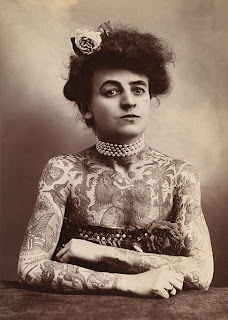A tattoo is made by inserting indelible ink into the dermis layer of the skin to change the pigment. Tattoos on humans are a type of body modification, and tattoos on other animals are most commonly used for identification purposes. The first written reference to the word, "tattoo" (or Samoan "Tatau") appears in the journal of Joseph Banks, the naturalist aboard Captain Cook's ship the HMS Endeavour in 1769: "I shall now mention the way they mark themselves indelibly, each of them is so marked by their humor or disposition".
Tattooing has been practiced for centuries in many cultures spread throughout the world. The Ainu, the indigenous people of Japan, traditionally had facial tattoos. Today one can find Berbers of Tamazgha (North Africa), Māori of New Zealand, Hausa people of Northern Nigeria, Arabic people in East-Turkey and Atayal of Taiwan with facial tattoos. Tattooing was widespread among Polynesian peoples and among certain tribal groups in the Taiwan, Philippines, Borneo, Mentawai Islands, Africa, North America, South America, Mesoamerica, Europe, Japan, Cambodia, New Zealand and Micronesia. Indeed, the island of Great Britain takes its name from tattooing, with Britons translating as 'people of the designs' and the Picts, who originally inhabited Britain, literally meaning 'the painted people'. British people remain the most tattooed in Europe. Despite some taboos surrounding tattooing, the art continues to be popular in many parts of the world.
Since the 1990s, tattoos have become a mainstream part of global and Western fashion, common among both sexes, to all economic classes, and to age groups from the later teen years to middle age. By the 2010s, even the Barbie doll put out a tattooed Barbie in 2011.
To read more on this interesting subject [link].
A tattoo is made by inserting indelible ink into the dermis layer of the skin to change the pigment. Tattoos on humans are a type of body modification, and tattoos on other animals are most commonly used for identification purposes. The first written reference to the word, "tattoo" (or Samoan "Tatau") appears in the journal of Joseph Banks, the naturalist aboard Captain Cook's ship the HMS Endeavour in 1769: "I shall now mention the way they mark themselves indelibly, each of them is so marked by their humor or disposition".
Tattooing has been practiced for centuries in many cultures spread throughout the world. The Ainu, the indigenous people of Japan, traditionally had facial tattoos. Today one can find Berbers of Tamazgha (North Africa), Māori of New Zealand, Hausa people of Northern Nigeria, Arabic people in East-Turkey and Atayal of Taiwan with facial tattoos. Tattooing was widespread among Polynesian peoples and among certain tribal groups in the Taiwan, Philippines, Borneo, Mentawai Islands, Africa, North America, South America, Mesoamerica, Europe, Japan, Cambodia, New Zealand and Micronesia. Indeed, the island of Great Britain takes its name from tattooing, with Britons translating as 'people of the designs' and the Picts, who originally inhabited Britain, literally meaning 'the painted people'. British people remain the most tattooed in Europe. Despite some taboos surrounding tattooing, the art continues to be popular in many parts of the world.
Since the 1990s, tattoos have become a mainstream part of global and Western fashion, common among both sexes, to all economic classes, and to age groups from the later teen years to middle age. By the 2010s, even the Barbie doll put out a tattooed Barbie in 2011.
To read more on this interesting subject [link].

No comments:
Post a Comment
Always great to hear from you :O)